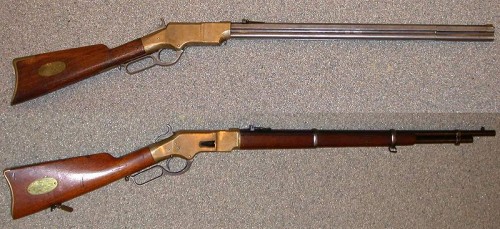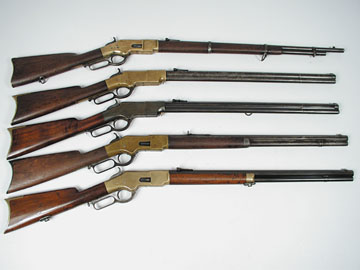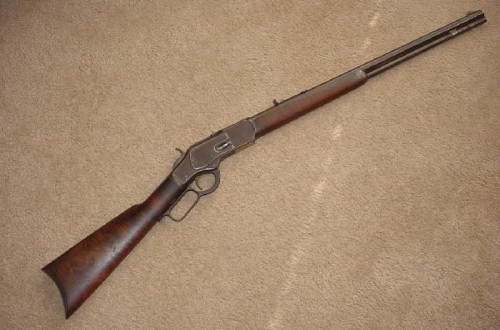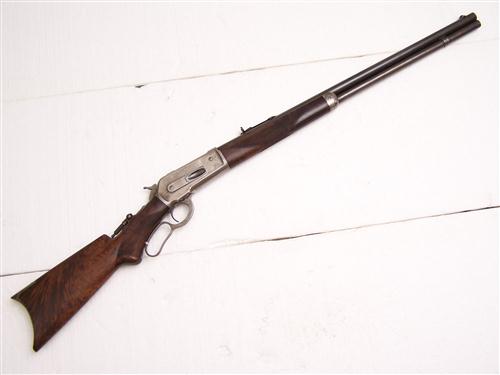The Winchester Repeating Arms Company was a prominent American maker of repeating firearms, located in New Haven, Connecticut. The Winchester brand is today used under license by two subsidiaries of the Herstal Group, Fabrique Nationale (FN) of Belgium and the Browning Arms Company of Morgan, Utah.
Lets see the story of one of the famous weapon of the Wild West.
The roots: The 1860 Henry rifle
The Henry rifle used a .44 caliber cartridge with 26 to 28 grains (1.7 to 1.8 g) of black powder.This gave it significantly less muzzle velocity and energy than other repeaters of the era, such as the Spencer. The lever action, on the down-stroke, ejected the spent cartridge from the chamber and cocked the hammer. A spring in the magazine forced the next round into the chamber; locking the lever back into position sealed the rifle back up into firing position. As it was designed, the rifle was not a very safe weapon. A Henry rifle, when not in use, would either have the hammer cocked or resting on the rim of the cartridge. In the first case, the rifle had no safety and was in firing position. In the second, an impact on the back of the exposed hammer could cause a chambered round to fire.
The Henry and the model 1866 are similar. Here are the two weapons:
Quiz: You can see the differences. What are these?
Winchester model 1866
The original Winchester rifle – the Winchester Model 1866 – was famous for its rugged construction and lever-action mechanism that allowed the rifleman to fire a number of shots before having to reload: hence the term “repeating rifle.” Nelson King’s new improved patent remedied flaws in the Henry rifle by incorporating a loading gate on the side of the frame and integrating a round sealed magazine which was covered by a fore stock. Originally chambered in the rimfire .44 Henry, the Model 1866 was nicknamed the “Yellow Boy” because of its “brass” receiver (actually a bronze alloy called gunmetal).
Henry rifles (the second and the third) and model 1866 Winchesters
Winchester model 1873
One of the most successful, and certainly one of the most famous Winchester rifles was the Winchester Model 1873. Originally chambered for the .44-40 cartridge, it was later produced in .38-40 and .32-20, all of which were also popular handgun cartridges of the day. Due to feeding problems, the original Model 1873 was never offered in the military standard .45 Colt cartridge, although a number of modern reproductions of the rifle are chambered for the round. The popularity of the Winchester in .44-40 led Colt to manufacture a version of the Single Action Army revolver chambered for the same round, called the “Frontier Model”
Winchester model 1876
The Winchester Model 1876 or Centennial Model was a heavier-framed rifle than the Model 1866 or Model 1873, and was the first to be chambered for full-powered centerfire rifle cartridges, as opposed to rimfire cartridges or handgun-sized centerfire rounds. While similar in design to the 1873, the 1876 was actually based on the prototype 1868 lever-action rifle that was never commercially produced by Winchester.
Originally chambered for the new .45-75 WCF cartridge (designed to replicate the .45-70 Gov’t ballistics in a shorter case), versions in .40-60, .45-60 and .50-95 Express followed; the ’76 in the latter chambering is the only repeater known to have been used in any numbers by the professional buffalo hunters.
Winchester model 1886
The Model 1886 continued the trend towards chambering heavier rounds, and had an all-new and considerably stronger locking-block action than the toggle-link Model 1876. It was designed by John Moses Browning, who had a long and profitable relationship with Winchester from the 1880s to the early 1900s. William Mason made some improvements to Browning’s original design. In many respects the Model 1886 was a true American express rifle, as it could be chambered in the more powerful black powder cartridges of the day, such as the .45-70 Government (chambering a rifle for the popular .45-70 had been a goal of Winchester for some time). The 1886 proved capable of handling not merely the .45 Gov’t but also the huge .45-90 and .50-110 Express “buffalo” cartridges,[7][8] and in 1903 was chambered for the smokeless high-velocity .33 WCF. In 1935 Winchester introduced a slightly modified M1886 as the Model 71, chambered for the very powerful .348 Winchester cartridge.
Winchester model 1892
Winchester returned to its roots with the Model 1892, which, like the first lever-action guns, was primarily chambered for shorter, lower-pressure handgun rounds. The Model 1892, however, incorporates a much stronger Browning action (based on the larger M1886) than the earlier Henry-derived arms of the 1860s and 1870s. 1,004,675 Model 1892 rifles were made by Winchester, and although the company phased them out in the 1930s, they are still being made under the Puma label by the Brazilian arms maker, Rossi, and by Chiappa Firearms, an Italian factory. In its modern form, using updated materials and production techniques, the Model 1892’s action is strong enough to chamber high pressure handgun rounds, such as .357 Magnum, .44 Magnum, and .454 Casull. The Winchester ’92 was commonly used in Hollywood Western movies and TV shows, as a substitute for the Winchester ’66 and ’73 models, because it has a similar appearance, and was cheaper and easier to acquire.
Winchester model 1894
The John Browning designed Winchester Model 1894 is perhaps the best known of the Winchester repeating rifles. The Model 94 was first chambered for the .32-40 cartridge, and later, a variety of calibers such as .25-35 WCF, .30-30, .32 Winchester Special, and the .38-55. Winchester was the first company to manufacture a civilian rifle chambered for the new smokeless propellants, and although delays prevented the .30-30 cartridge from appearing on the shelves until 1895, it remained the first commercially available smokeless powder round for the North American consumer market. Though initially it was too expensive for most shooters, the Model 1894 went on to become one of the best-selling hunting rifles of all time—it has the distinction of being the first sporting/hunting rifle to sell over one million units, ultimately selling over seven million before US production was discontinued in 2006. The Winchester 94/.30-30 combination is practically synonymous with “deer rifle” in the United States.
And we arrived to the XX. century. The wild west wasn’t so wild anymore…….
Page by SAPE







very good!sape
@Sape:
Have you ever been shoting the Winchester model in real life?
Thanks you Brothers. 🙂
@Jippi: No, just a .22 Marlin.
http://www.marlinfirearms.com/Firearms/22Rifle/Golden39A.asp
Very very big feeling. And you?
I like the winnie, he is beautiful made as weapon with the wood, etc. Much better than the schofield (for me 🙂 )
Very good page again, a lot of information. It’s wonderful that the winchester 1894 is produced until 2006.
great work and interesting information!! big thx to you!
GG Sape!!! Thank you! 🙂